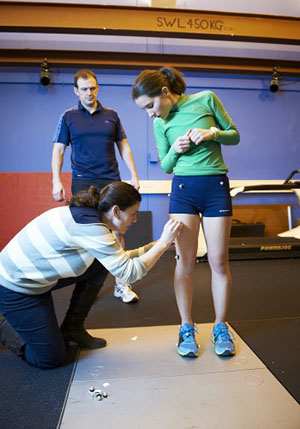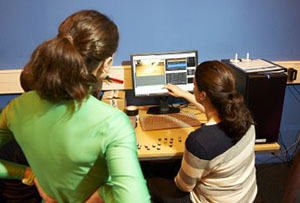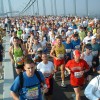It’s my second trip to the University of Bath’s applied biomechanics lab. This time, rather than quizzing the scientists about their research for my Mosaic feature, I’ll be part of it. I’m due to be kitted out like Andy Serkis playing Gollum in Lord of the Rings. If you’ve seen the behind-the-scenes documentaries, you’ll know what I mean. I’m going to have reflective bobbles stuck to various “anatomical landmarks,” so that the lab’s hi-tech motion-sensing system can track my movements in 3-D space. The idea is to look at how my running style affects the forces that my knee is subjected to when I run, as part of a study designed to throw some light on running injuries.
The team here are comparing runners who strike the ground heel first and those who strike it forefoot or midfoot first. I’m the pilot participant and, as established at our last meeting, I’m firmly in the heel-strike camp. When I arrive at the lab, biomechanics researcher Polly McGuigan and master’s student/physio Damon Newrick are poring over their computer, trying to figure out their new motion-sensing software. They’re excited, but they don’t really know what they’re doing yet. As for me, I’m completely at their mercy, and a bit edgy because the university photographer has just turned up.
There’s a lot of setting up that has to go on before we get to any running. It’s the bobbles that take up the most time. While I stand on the force plate, which will measure the force I exert on the ground, what look like oversized silver cake decorations are applied to my right ankle, knee and pelvis. I try not to appear self-conscious as the photographer, Nic, snaps Damon at crotch height, trying to feel the location of my pelvic bone.

Only a minute or two after the bobbling process has begun, Damon looks me square in the hips and says, “One hip’s higher than the other.” I know. I’ve been having physiotherapy to try to realign my unbalanced pelvis. This has involved a series of arduous core stability exercises, one of which my husband and I have dubbed “pushy pushy,” on account of him having to poke and jab at me while I lie or stand in various positions. It’s less rude than it sounds. Anyway, at this point, I’m not particularly fazed by someone telling me I’m uneven, but I am a little surprised that anyone—even a trained physio—could pick up the difference without looking for it.
The experiment itself is straightforward. When all the bobbles have been correctly applied, Polly asks me to run in a straight line across the center of the lab, hitting the force plate with my bobbled right foot. I mean, I say it’s straightforward. It’s actually a bit of a knack hitting the plate with the correct foot and it takes me a couple of attempts to get it right. Then it’s just a case of starting in the same place every time—like a long-jumper who’s put down their mark on the runway. I repeat the run 10 times, while Polly and Damon sit at the computer collecting my data. As I run, giant cameras on stilts track the reflective bobbles on my leg and create a moving map of their coordinates.
The result is a weird, amputated leg model bouncing around in black space on a computer screen. After a few runs and some fiddling about with the settings on the software, there’s a sudden “oooooh” moment. We all crowd around the screen. Polly has worked out how to layer the bobble coordinates on top of film footage of my runs. I can now see myself running over the force plate with all my anatomical landmarks highlighted. Which is nice.

It’s a pleasing experiment because it offers instant results, or at least instant data, because we don’t yet know what any of it means. As is the way with academic publishing, it will be some time before I see a study published from all of this. But I have more a sense of what they’re looking for by the time I’ve completed the second part of their experiment.
To understand how my knee is “loading”—how forces press and strain at it—as I run, they need the data from the force plate, but they also need to know how strong my leg is. So I’m asked to undertake some fairly strenuous resistance exercises with my right leg, while strapped into a high-backed chair, with Damon shouting “PUSH, PUSH, PUSH!” at me and Polly saying things like “Nice explosive rate of force development” and “Good facial expressions!” The point is to work out what proportion of the strength in my hamstring and quadriceps muscles I’m using as I run, and how that relates to the loads on my knee.
According to the participant information sheet I’ve been given, knee injuries are the most common running injuries. When Polly and Damon have the data from all their participants, they’re hoping it will tell them something about the difference in the risk of knee injury between heel strikers and non-heel strikers. Their study will contribute to the debate on changing your running style. Runners are increasingly being advised to change their style to a forefoot or midfoot strike, despite a lack of evidence to show it would help.

It’s been fascinating to be part of a real scientific experiment and here is nothing like the sterile lab environment that most people probably imagine. Polly and Damon definitely have a lot more fun in their biomechanics lab than I ever did during my short time in experimental cardiology, I think. Then I remember that they still have a lot of work to do. Once the initial excitement has worn off, sticking bobbles on and shouting at people, over and over again, not to mention all the data analysis, might not be such fun. It’s a hard job, science, even when you’re playing at Lord of the Rings.

RELATED STORY
Using the Power of Science to Tackle a Marathon
This post originally appeared on Mosaic as “Running for Science” and is republished here under a Creative Commons license.





